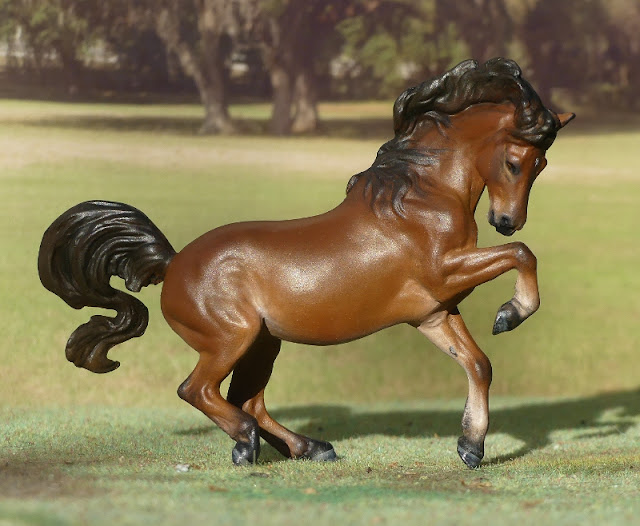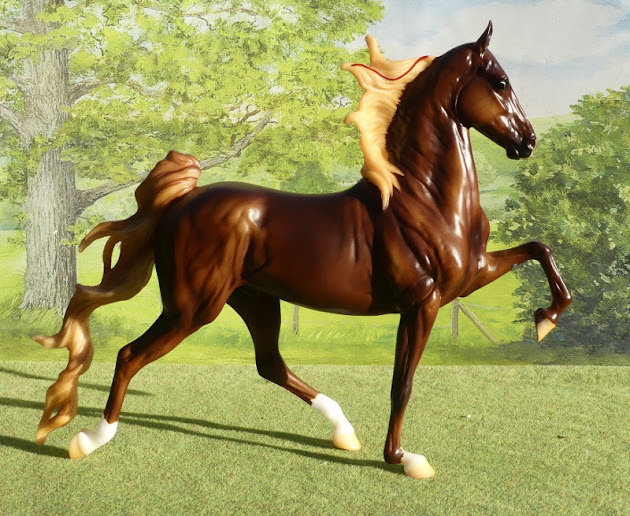A very special introduction today, she deserves a post all to herself! Out of all existing Stablemate moulds, I think the Mini Connemara Pony is the best match for my own horse, so I'd set one aside from my recent parcel, and now I've painted her up.
Here's a couple of pictures of the real one, first - her colour changes from reddish in winter, then darker brown while she sheds, and ends up quite sandy gingery in the summer, so I've had to pick out a selection of older shots which match the colour variation I painted!
This horse is my best mate, not just an animal but a great friend too. She arrived at the yard as a foal, was put in with my shetland pony for company, and I was asked to provide a bit of care and education while she grew up - the owner's intention was to sell her a couple of years later, when she was ready to start bringing on. But by then she'd clearly decided she was my horse, we'd palled up and she trusted me, played with me, and followed me everywhere like a pet, so I bought her so she could stay.
As many of you will already know, her name is Foal, even though she's ten soon and 'foal' is the term for a horse under the age of one year - it dates back to when she was new and we all just referred to her as 'The Foal', and it stuck.
From when I was training her to ride, looking actually tame and reasonably sensible for once! We're both retired from that now, and I just hang out with her in the field for a couple of hours in winter, much longer in summer.
Fluffy creature! She's a cross between two British native breeds, with a New Forest Pony father and a Welsh Cob mother - in looks and build she very much resembles her New Forest half, but her mind is very 'Welshie' : opinionated, highly strung, playful, clever, protective, and stubborn.
And here's the mini version...
Because she's such a playful, bouncy horse, this mould suits her surprisingly well. I tend to like it most as feral breeds (like the Sable Island Horse Breyer released on the large version), but I've seen her doing this sort of dramatic flailing on a regular basis, often when she's just got up from a particularly good wriggly roll!
She's the wild-type bay, which means her legs aren't fully black - her knees and hocks are chocolatey brown, her fetlocks are black, and the front legs have patches of creamy blonde between the two. She's also got gingery highlights in her mane and tail, so I didn't paint in the mane strands like I would usually on a mould where the hair's sculpted flat against the neck and shoulder, but let it fade out as if the hair's browner toward the tips.
She's got a little thumb-smudge of white on her forehead in real life, which I added in with a tiny brush for her miniature self.
The mould isn't strictly supposed to stand up in a half-rearing pose like this (you can tell from the awkward angle of the foot furthest from the camera), but it looks fun to vary the photos a little bit.
This shot, angled to obscure the fact that far-side foot isn't flat on the floor, looks more convincing!
I really like how she turned out, not purely cos it's satisfying to finish a custom neatly and nicely and match a colour accurately, but it's just lovely to have an adult portrait of her for my Stablemates collection! Last time I painted one, I used the scratching foal mould, but she hasn't been that size for a very long time now, so she deserved a grown up model as well. I'll find the foal picture....
There! The two models haven't 'met' yet, I'll have to take a picture of her Stablemate selves standing together. I told the real one this morning I'd been painting her again, but she was more interested in trying to get my pocket buttons in her mouth!
Finally, something I noticed while setting up my pictures...
Laying down, the mould looks like it's having a roll!
Here's the real one - she really does love rolling on her back and both sides, one of her nicknames is 'Rolly-Foaly' (and the farmer who brings her hay bales thinks her name is actually 'Rolly' and never calls her anything else!)
Good job I painted the underneath pretty well, I admit I don't usually do much detailing or referencing with the underside of models, but because this one was a portrait I made sure I copied her shading all over, so she even looks accurate in this roll pose!















































